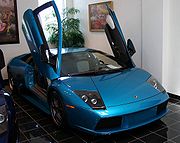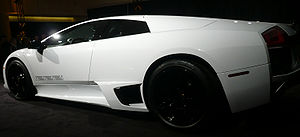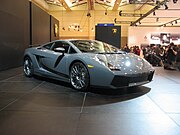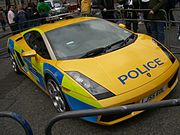Lamborghini Murciélago

The
Lamborghini Murciélago is a high performance sports car produced by Italian automaker Automobili Lamborghini S.p.A. and designed by Luc Donckerwolke. It was introduced in 2001 as the successor to the Diablo. The Murciélago is a two-door, two-seat coupé. To celebrate the company's 40 years in operation, 50 special edition Murciélagos were built during the autumn of 2003. An open-top version called the
Murciélago Roadster was introduced in 2004 for the 2005 model year. The roadster features similar performance to the coupé with a more aggressive rear flank, as well as a considerably higher price tag.
The Murciélago sports a 6.2-litre version of the Lamborghini V12 engine, a six-speed manual or 6-speed sequential automatic transmission, and four-wheel drive. It also has a rear spoiler that can be raised to an angle of 70 degrees, side mirrors that fold in to improve aerodynamics, and side scoops that automatically open to the needed size to let in just the right amount of air needed to cool its engine. The 2008 car's estimated fuel economy for the 6-speed manual is 8 miles per US gallon (29 L/100 km; 9.6 mpg-imp) city and 13 miles per US gallon (18 L/100 km; 16 mpg-imp) freeway, making it the least efficient 2008 car for city and highway driving, according to the EPA.
The coupé's base price is US $313,000, which is US $107,000 more than its smaller sibling, the Lamborghini Gallardo.
In 2006 the Murciélago's engine was replaced by a stronger 6.5-liter engine and the car's name was changed to Murciélago LP640. For the 2007 model year Lamborghini did the same with the roadster model, which is now called Murciélago LP640 Roadster. Both versions received a minor facelift.
The name
The name Murciélago (pronounced moor-thee-EH-la-go in traditional Castilian Spanish and moor-see-EH-la-goh in Spanish of Latin America) means "bat" in Spanish. A bull by this name survived 24 sword strokes in an 1879 fight at the arena of Córdoba, and fought with such passion and spirit that the matador chose to spare its life, a rare honor. In another Lamborghini tie-in, the bull was later presented as a gift to Don Antonio Miura, who was a noted breeder and whose bull ranch the Lamborghini Miura was named after, and went on to sire a line of famous fighting bulls.
40th Anniversary Edition

Lamborghini Murciélago 40th Anniversary Edition
In late 2003, Lamborghini announced a special 40th Anniversary Edition of the Murciélago, following in the footsteps of their Countach and Diablo Anniversary Editions. The limited production run of 50 vehicles featured enhancements including a limited-edition body color, carbon-fiber exterior detailing, upgraded wheels , a new revamped exhaust system, and a 40th Anniversary numbered plaque displayed along the side. The interior featured a new leather trim and additional electronic features.
LP640
The LP640 version was first shown at the Geneva Motor Show in March 2006, as a facelift for the coupé version. It features a 6.5 Litre engine, now producing 640 PS (631 hp/471 kW), improving performance substantially. Like the base Murciélago, the engine is mounted "backwards", with the transmission in front of the engine and the differential behind it, instead of a transaxle normally seen on mid-engine cars. There were also a few minor external changes, primarily to the low air intakes.

LP640 Roadster at the 2007
Los Angeles Auto Show
The front and rear bumpers have been reshaped to channel air more efficiently, and the new exhaust has been shaped into the rear diffuser to minimize aerodynamic lift. The air intake on the left side has been enlarged to accommodate the feeding of the oil cooler. The car's body is made up of steel and carbon fibre, while underneath a revised suspension has been added to keep up with the car's performance. It also has an all-wheel-drive system that normally distributes 70% of the torque to the rear wheels, but can allocate up to 100% to the rear, or up to 70% to the front, depending on where the available grip is. There are also new 18-inch (460 mm) Hermera alloy wheels running huge 335/30 tyres at the rear. The LP640 retains the original car's scissor-opening doors. The LP640 coupè U.S. MSRP rests at $318,800.
Inside the LP640, the seating has been reshaped to accommodate greater headroom, while an upgraded instrument panel is flanked by an improved stereo system.
The LP640's optional equipment includes Carbon fibre-reinforced Silicon Carbide (C/SiC) ceramic composite brakes for swifter braking, chrome paddle shifters and a glass engine cover which shows off the LP640's engine.
A special edition version of the Murciélago LP640 was introduced at the Paris Motor Show. The Versace edition features a customized all-white exterior and a matching white interior. However, a one-of-a-kind black LP640 Versace and LP640 Roadster Versace were also presented by the factory.
Lamborghini announced the LP640 Roadster version at the 2006 LA Auto Show.
Engine
LP stands for Longitudinale Posteriore, referring to the longitudinally-mounted, 6.5L V12 engine, capable of producing up to 640 PS (631 hp/471 kW) @ 8000rpm. Along with a new six-speed manual transmission, which can come in Lamborghini's optional paddle shift "E-gear" package, the LP640 can reach a top speed of 219+ mph. The LP640 is accommodated by an electronic Launch control device called "Thrust."
LP640 Roadster
The new Lamborghini Murciélago LP640 Roadster was presented on the 2006 Los Angeles Autoshow. It features the same engine as the LP640 coupé and replaces the 6.2 Litre Murciélago Roadster. The only design changes were oil cooling vents behind the air intakes, interior changes, and a reinforced body.
LP640 Versace

LP640 Versace Edition at Toronto Autoshow 2008, with the white-black trim in the door
Presented at the 2008 Paris International Autoshow, the Lamborghini Murciélago LP640 Versace is a special edition version of the Lamborghini LP640 Coupé, with all the same performance features. The only difference is the two tone white-black trim, shown on both the exterior and interior of the car. However, Lamborghini de Spa have also built 1 black LP640 & LP640 Roadster. It also features custom Versace leather seating and a Gianni Versace logo plaque inside the vehicle. The Versace material costs $10,000 per seat. Lamborghini have also announced that they will only produce 20 units of this model.
LP 650-4 Roadster
It is a limited production (50 units) model. Engine is rated 650 PS (641 hp/478 kW) at and 660 N·m (487 lb·ft) torque. Exterior changes include Grigio Telesto exterior that combines grey bodywork with a special bright orange Arancio LP 650-4 featured on the front spoiler and sills, orange brake calipers and a transparent V12-engine cover. Interior changes include black Alcantara Nera on the driver's side (including door panel and central tunnel), and black leather Nero Perseus on the passenger's side.
LP 670-4 SuperVeloce

A Lamborghini Murciélago LP 670-4 Superveloce in Irvine, CA
The Murciélago LP 670-4 SuperVeloce is the latest and most extreme variant of the Murcielago models. Engine power was increased to 670 PS (661 hp/493 kW) at 8000 rpm and 660 N·m (487 lb·ft) at 6500 rpm torque through engine airflow enhancements and improved valve timing.
The vehicle is 100 kilograms (220 lb) lighter than predecessor via new super high-strength sectional steel on chassis (-20 kg (44 lb)); carbon fiber based front fenders, rear side panels/fenders and the casing for the third brake light, removing drive for moveable spoiler (-13 kg (29 lb)); carbon fiber door panels, cockpit, roof lining, Alcantara upholstered seat (leather seat available as option), omission of the radio-navigation system (available as option) (-34 kg (75 lb)); lighter single disc clutch, lighter exhaust system (-26 kg (57 lb)); ceramic disc with carbon ceramic brakes, "Ares" alloy-forged wheels (-7 kg (15 lb)). The car now has a dry weight of 3,450 lb (1,560 kg).
The e.gear transmission became standard, which includes "Corsa" and a "Low adherence" modes; while 6-speed manual transmission became a no-cost option.
Handling is improved via stiffened chassis, enlarged front spoiler and the twin rear diffuser, the new fixed rear spoiler. Buyer can choose between small rear spoiler or the optional larger Aeropack Wing (a large, fixed, carbon-fiber wing mounted on two carbon-fiber brackets) for improved downforce. Suspension is the same as the LP640.
Lamborghini estimated 0-100 km/h acceleration of 3.2 seconds, with top speed of 342 kilometres per hour (213 mph) (337 km/h (209 mph) with Aeropack Wing).
The car was unveiled in 2009 Geneva Motor Show.
Motorsport

Reiter Engineering's Murciélago R-GT, campaigned under the
InterProgress Bank Spartak Racing name
The Lamborghini Murciélago R-GT is a race-only version of the Murciélago, developed jointly with Reiter Engineering and Audi Sport. It has rear-wheel drive unlike the standard Murciélago to comply with the FIA, ACO, and JAF rules. The car retains the standard Murciélago V12, but has air restrictors to manage power. Its acceleration and top speed are highly dependent on the gearing selected for a particular race track.
In March 2006 at the Super GT Suzuka 500 km, a Murcielago R-GT specifically built for Super GT (and rebadged RG-1) for the Japanese Lamborghini Owners Club (JLOC) recorded the first win ever for a Murcielago when they earned a win in the GT300 class. In March 2007 in the FIA GT Championship, the All-Inkl.com Racing Murciélago won the Zhuhai 2 Hours.
In December 2006, Reiter Engineering tested an upgraded Murcielago R-GT LM, featuring redesigned body work and a new rear wing with less drag.
In April 2009, in LMS 1000 km de Catalunya race, a Murcielago R-GT of the russian IPB Spartak Racing Team has won the GT1 class, against Corvette C6-R and Saleen S7-R. The drivers of the IPB Spartak Racing car were the russian Roman Rusinov and the dutch Peter Kox. They crossed the finish line 2 laps ahead of the first Corvette, in 2nd place. Before of the race, Lamborghini has set the pole, but has been moved at the end of the grid due to some technical irregularities. The second, international win for the Ragin Bull GT car. In 2009 LMS, IPB Spartak Racing is in the firts place of the GT1 class.
Cars based on the Murciélago
Lamborghini Miura Concept

Lamborghini Miura Concept
A Lamborghini Miura concept car was presented at the Museum of Television & Radio on January 5, 2006 alongside the Los Angeles Auto Show, though it was not present at the show itself. Instead, the Miura officially debuted at the North American International Auto Show two weeks later. It was the first design by new Lamborghini chief, Walter de'Silva, and commemorates the 1966 introduction of the original Miura in Geneva.
Lamborghini president and CEO Stephan Winkelmann has denied the concept will return the Miura to production, saying “The Miura was a celebration of our history, but Lamborghini is about the future. Retro design is not what we are here for. So we won’t do the Miura.”
 e giant has set out to release a four doored coupe variant of it's engineering excellence to the world. With cars from companies like BMW, Audi and Mercedez that combine the performance and handling of a sportscar with enough room and luxury for four people sales have been going downhill. So, along with Porsche and Aston Martin, Lamborghini has made up it's mind to get back to the top in the charts. The show car had the engine and AWD system from the Gallardo.
e giant has set out to release a four doored coupe variant of it's engineering excellence to the world. With cars from companies like BMW, Audi and Mercedez that combine the performance and handling of a sportscar with enough room and luxury for four people sales have been going downhill. So, along with Porsche and Aston Martin, Lamborghini has made up it's mind to get back to the top in the charts. The show car had the engine and AWD system from the Gallardo.


















 Because of the reputation of the Lamborghini as a fierce fighter on the road, it has been able to attract the attention of game designers, directors etc. Many games of the Need for Speed series like NFS: Hot Pursuit 2, Need for Speed: Most Wanted, Need for Speed: Carbon & Need for Speed: ProStreet
Because of the reputation of the Lamborghini as a fierce fighter on the road, it has been able to attract the attention of game designers, directors etc. Many games of the Need for Speed series like NFS: Hot Pursuit 2, Need for Speed: Most Wanted, Need for Speed: Carbon & Need for Speed: ProStreet
 "With 571 horsepower put to the pavement through a permanent 4WD system, the Lamborghini Murciélago is capable of 205 miles per hour."
"With 571 horsepower put to the pavement through a permanent 4WD system, the Lamborghini Murciélago is capable of 205 miles per hour."


 The Lamborghini Murciélago is a high performance sports car produced by Italian automaker Automobili Lamborghini S.p.A. and designed by Luc Donckerwolke. It was introduced in 2001 as the successor to the Diablo. The Murciélago is a two-door, two-seat coupé. To celebrate the company's 40 years in operation, 50 special edition Murciélagos were built during the autumn of 2003. An open-top version called the Murciélago Roadster was introduced in 2004 for the 2005 model year. The roadster features similar performance to the coupé with a more aggressive rear flank, as well as a considerably higher price tag.
The Lamborghini Murciélago is a high performance sports car produced by Italian automaker Automobili Lamborghini S.p.A. and designed by Luc Donckerwolke. It was introduced in 2001 as the successor to the Diablo. The Murciélago is a two-door, two-seat coupé. To celebrate the company's 40 years in operation, 50 special edition Murciélagos were built during the autumn of 2003. An open-top version called the Murciélago Roadster was introduced in 2004 for the 2005 model year. The roadster features similar performance to the coupé with a more aggressive rear flank, as well as a considerably higher price tag.























